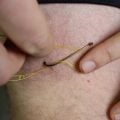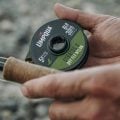How to Tie a Super Simple Cicada
Producer: Tim Flagler
Just in time for the upcoming Brood X Cicada hatch, and in conjunction with Douglas Outdoor’s annual Fly Off competition – which this year features a Cicada category as well as a standard trout fly category – this week’s fly is a super simple Cicada.
Although ultra realistic imitations look cool, I think all you really need to attract a trout’s attention is something that goes “splat” and can be aggressively moved on the water’s surface without sinking. To that end, the body of this fly is formed using four layers of 2 mm craft foam – 3 black plus an orange accent layer. The layers get laminated together using an adhesive, such as 3M’s Super 77. Once bonded, the stack becomes a single unit that’s somewhat flexible and completely waterproof.
A foam body cutter, like this large beavertail-style one from River Road Creations is key to creating a professional looking body. Four 2 mm layers of craft foam is about the tool’s max but it handled the job with ease. A whole bunch of bodies can be cut out in just a few minutes. Get hold of one of the foam bodies and prep it by snipping off the narrow front tab. While you’re doing foam work, punch out a series of holes on a piece of orange 2 mm craft foam and collect the resultant dots. One of these will be used to create a hot spot and make the fly more visible.
A beautifully-shaped and ridiculously sharp Ahrex HR418 Bomber hook in size 4 fits well with the large foam body. Get the hook firmly secured in the jaws of your tying vise. Notice the hook has a return-style eye, this needs to be closed prior to tying in materials starts.
For thread, I’ve loaded a bobbin with a spool of black UTC 140 Denier. You can jump up to a heavier thread or even something gel-spun, if you prefer. Get the thread started behind the eye and take a few tight wraps to close the return and to anchor your tying thread. Continue taking thread wraps down the hook shank a short ways before lifting the excess tag end up and snipping it off close. Keep taking thread wraps down the shank to create a nice, even thread base for the fly. Stop when your thread hangs at about the hook point, then take a few open spiral wraps back up the shank.
Black, rabbit fur dubbing is used to create an underbody on the fly, which will help to adhere the foam, and keep it from rotating around the hook shank. Build an ample 4-5” long noodle on your tying thread, don’t be shy with the dubbing here. Start taking wraps with the noodle to cover up the entire thread underbody. At the front of the fly, reach for another clump of dubbing and use it to build a dubbing noodle just like the last one. With the noodle complete, wrap it down the hook shank, over top of the existing dubbing, to finish the underbody. Try to get it to taper gently at both ends. Leave your tying thread hanging at the hook point.
Reach for your superglue, here, Fly Tyers Z-Ment, and apply a very liberal coating to the top of the dubbed underbody. Align the front edge of the prepped foam body with the front of the hook eye, and be sure it’s centered on top of the hook shank. Take a full wrap of tying thread over top of the body and gently pull down. Take subsequent wraps around the foam, pulling down a little harder each time. The pressure of the thread wraps will set the adhesive at this rear point. Angle your tying thread forward on top of the hook shank but under the foam. Then, press the foam down and take a thread wrap just in front of the bulge on the foam body. Repeat the same tie-down procedure you did at the rear of the fly. Now, the superglue should’ve completely set and the foam body should be well anchored to the top of the hook shank.
Orange/black barred, medium-sized round rubber legs are used to imitate the Cicada’s somewhat stubby little legs. Snip a single strand free from the hank. Double the strand over and find it’s midpoint. Place the midpoint on top of the foam body, above your tying thread, and take two wraps to lightly anchor it. This will allow you to pull one of the strands down on the near side of the body and the other down on the far side. Position the strands about halfway down the body then take a few more tight thread wraps to firmly anchor them there.
Pearl Krystal flash is used for the underwing of the fly. Snip 6-8 strands free from the hank. Place the snipped-off ends on top of the foam body so they go about halfway across, and anchor them with tight thread wraps. Pull rearward on the flash and snip it off square so the strands are just slightly longer than the body of the fly. Hold on to the snipped-off portion and place the snipped-off end next to the first clump, on top of the foam body then anchor it with wraps of tying thread. Trim this clump off to the same length as the first. The fly should now look something like this.
Once again, reach for the super glue and, this time, place a healthy drop on top of the thread wraps that bind down the Krystal flash. Give the area a little finger pressure to make sure the adhesive sets.
Tan deer body hair is used for the over wing of the fly. The hair should be slightly longer than one of the foam bodies. Snip an ample clump free from the hide, about a half a pencil diameter’s worth, and clean out the fuzzies and short hairs from the butt ends. Place the clump, tips first, into a wide mouth stacker and give it a vigorous stacking. Open the stacker and get hold of the aligned tips. Place the hair on top of the fly so the tips extend just past the ends of the Krystal Flash. Re-grip the clump in the fingers of your left hand then reach in with the tips of your tying scissors and snip the butt ends off, right above your tying thread. Push down on the snipped-off butts and take thread wraps to secure them. The deer hair is going to want to spring up dramatically, but that’s ok. Just make sure it’s anchored well.
Pick up one of those foam dots you punched out earlier and place it on top of the deer hair butts. Take a thread wrap over top of the middle of the foam dot, like so. Pull down on your tying thread while you keep the dot centered on top of the fly. Continue taking thread wraps to further bind the foam dot down. You should notice that it pushes the wing down just a bit, which is good.
Go back to the packet of black rabbit fur dubbing and pull out a small amount. Use the dubbing to create a fairly short noodle on your tying thread. Start taking wraps with the noodle to cover up the thread wraps below. Re-orient the hook in your tying vise to give you easier access to the eye. Pull back on the foam and take a few wraps to secure your tying thread behind the eye. Then get hold of your whip finish tool and use it to do a 5 or 6 turn whip finish, seat the knot really well and snip or cut your tying thread free. You can then reorient the fly back to its normal position in your tying vise.
Snip the midpoint of the front loop to produce two front legs, then snip all four legs off so they’re fairly short, just a little more than a hook gap in length. Flip the fly over in your vise and apply a liberal coat of head cement, or here, Sally Hansen Hard as Nails, to the exposed thread wraps on the underside of the hook behind the eye.
And that’s the Super Simple Cicada. It’s not going to win any fly tying competitions, because of it’s simplicity. I do, however, believe the fly will be enough to fool cicada-crazed trout once this whole Brood X thing gets up and rolling.
How to Tie a Super Pupa
How to Tie a Swimming Caddis Nymph











